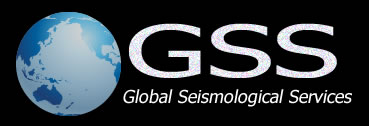The Kamchatka cluster is named for the Kamchatka Peninsula in the far
east of Russia, and covers the subduction zone along southern
Kamchatka’s Pacific coast. The region is intensely active, most notably
with the 9.0 Mw earthquake of Novermber 4, 1952 and the 8.8 Mw
earthquake of July 29, 2025. The cluster includes both earthquakes
(indicated by larger red stars in the base map), as well as the
September 13 (7.4 Mw) and September 19 (7.8 Mw) aftershocks of the 2025
mainshock, indicated by smaller red stars in the base map, but the point
of this cluster is not to represent the full pattern of seismicity in
the region; it is to provide a framework of calibrated hypocenters which
can be a reference point for more detailed studies of the seismicity. As
in most subduction zone settings, most of the seismicity in southern
Kamchatka is off-shore and therefore is not amenable to direct
calibration because of poor azimuthal coverage. However, by careful
selection of earthquakes, including events that occurred at greater
depths (to ~190 km) in the subduction zone, a cluster with good
azimuthal coverage for direct calibration can be assembled. It is
possible to add additional events to this kernel, of course, but adding
too many offshore events destabilizes the location calibration and even
if that were not the case, the shear number of large earthquakes in this
region overwhelms the computational capacity of the relocation code.
Therefore the strategy for placing more of the seismicity of this
important seismic zone in a location-calibrated context is to first
establish this calibrated framework which includes well-recorded events
from 1952 through 2025. Then subsets of the seismicity in the southern
Kamchatka subduction zone, such as a fuller representation of the 1952
sequence, can be relocated with calibrated locations through the
indirect calibration process, making use of the reference locations
determined in this cluster. All earthquakes in the cluster have depth
control, often from both direct arrivals at short epicentral distance
and from teleseismic depth phases. After the 1952 and 2025 mainshocks,
events are selected mainly on the basis of being well-recorded
teleseismically and also having observations at local seismograph
stations that provide the azimuthal coverage needed for a stable direct
calibration. Another criterion is temporal continuity from 1952 through
2025, so that the cluster adequately represents the evolving network of
regional and global seismograph stations. Direct calibration is based on
a simplistic flat-layered crustal model which is obviously a poor
representation of the true velocity structure of a subduction zone. To
some extent the resulting increased scatter in residuals is reflected in
the uncertainties of hypocentral parameters but there is undoubtedly
some remaining systematic bias in the hypocenters.
